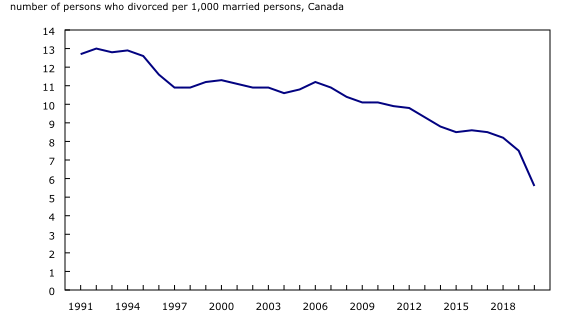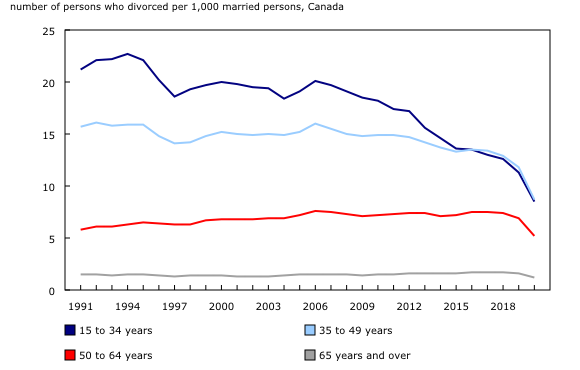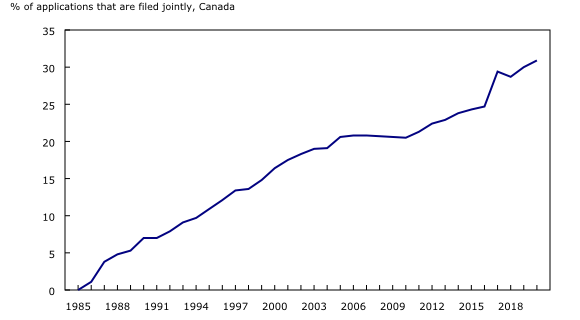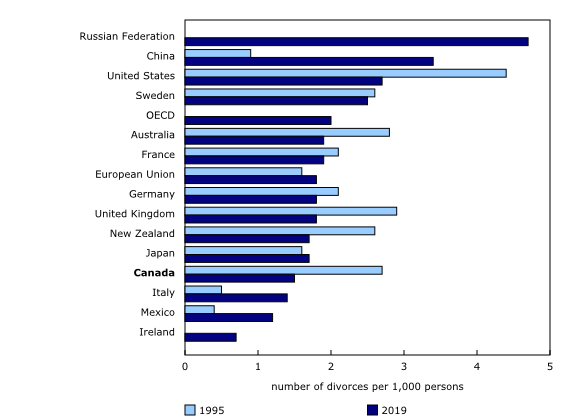Statistics of Divorced People Getting Together Againtrackidsp006
Released: 2022-03-09
Highlights
• The number of divorces recorded in 2020 (42,933) was the lowest since 1973.
• Barriers to accessing court services during the COVID-19 pandemic likely contributed to the decrease in divorce applications and granted divorces in 2020.
• The decrease in the divorce rate since 1991 is linked to the aging of the married population.
• Since the mid-2000s, age-specific divorce rates have been declining most rapidly for young adults while they have plateaued for persons aged 50 and over.
• Almost one-third of divorces are now the result of a joint application by both spouses.
• In 2019, Canada had the second lowest crude divorce rate among G7 countries.
• In the period from 2016 to 2020, divorce rates were highest in Yukon and Alberta and lowest in Nunavut and Newfoundland and Labrador.
Sharp decrease in divorces between 2019 and 2020
In 2020, there were 42,933 divorces granted in Canada, a sharp decrease from the 56,937 divorces recorded in 2019. While the number of divorces in the country has been generally declining for many years, this 25% annual drop is the largest since the Divorce Act of 1968 came into force. Difficulties accessing courts services during the COVID-19 pandemic likely contributed to this decrease which coincides with the onset of the pandemic.
The number of divorces in 2020 was the lowest since 1973 and less than half the highest number recorded in 1987. That year, 97,773 divorces were granted following amendments to the Divorce Act that reduced the minimum period of separation required before being granted a "no-fault" divorce from three years to one year.
Infographic 1 
General decline in the number of divorces in the past decades, but sharper decrease in 2020

The pandemic has created obstacles for the processing of divorce cases
Public health measures introduced during the pandemic were likely important drivers of the relatively low number of divorces recorded in 2020. In fact, lockdowns, slowed court proceedings, the adjournment of less urgent cases, and the temporary closure of some courts created barriers to accessing court services.
The social and economic disruptions associated with the pandemic may also have led to a change in the number of couples seeking to divorce. However, this specific effect cannot yet be seen in divorce statistics for the year 2020. In the case of 'no-fault' divorce applications—which have traditionally constituted the majority of applications—couples must separate for at least one year before a divorce may be granted. As a result, the full impact of these disruptions on the number of divorces will only begin to be seen in 2021.
Infographic 2 
Sharp decrease in divorce applications and granted divorces in the early months of the pandemic

The monthly number of divorce applications filed with the courts declined markedly beginning in March 2020. However, by July 2020, the number of applications had recovered to a level similar to that of previous years.
The number of divorces granted each month by the courts also fell at the beginning of the pandemic. However, unlike the number of applications, the number of divorces granted in December 2020 had yet to return to the level of recent pre-pandemic years. A similar pattern was found in a case study of monthly divorces in five American states.
In addition, the time elapsed between the filing of the divorce application and the granting of the divorce has increased since the start of the pandemic. While the median duration of this process was 4.8 months for divorces granted in 2018 and 2019, it increased by a month in 2020 (5.8 months).
Fewer divorces in all provinces in 2020
All provinces experienced a decrease in the number of divorces between 2019 and 2020. The decrease was particularly strong in Ontario (-36%). In the other provinces, the decrease was between 11% (New Brunswick) and 22% (Alberta).
In contrast, the number of divorces remained stable in the territories, with the exception of Nunavut where annual fluctuations are common given the low number of divorces granted each year.
Divorce statistics reflect only part of all union dissolutions
A divorce is a legal process that ends a marriage. Therefore, divorce statistics do not cover the separations of married couples nor the dissolutions of common-law couples.
Most married couples separate before filing for divorce, and some separated couples may never legally divorce. Moreover, since the share of common-law couples—for whom divorce does not apply—has increased from 6% of all couples in Canada in 1981 to 21% in 2016, divorce statistics increasingly underestimate total conjugal instability. This is particularly true in Quebec and the territories, where common-law unions are more prevalent.
Although divorce statistics do not reflect all union dissolutions, they provide valuable information on the state of marriage as an institution in Canada. They are also the only annual statistics available on union dissolutions, since no official record is kept of the separation of married or common-law couples.
The 2017 General Social Survey on the family provides the most recent survey-based information on the separation of married and common-law couples.
The 2021 Census of Population will provide statistical information on the number of Canadians currently divorced, separated, married or living common law.
Falling divorce rate since 1991 is linked to the aging of the married population
The decrease in the number of divorces over the last three decades has occurred despite growth in the population at risk of divorce, that is, married persons. As a result, the divorce rate—which corresponds to the number of persons who divorce per 1,000 married persons—decreased from 12.7 per 1,000 in 1991 to 7.5 per 1,000 in 2019, and fell further to 5.6 per 1,000 in 2020.
Chart 1 
Steady decline of the divorce rate since 1991

Two key societal changes have contributed to the general decrease in the divorce rate observed over the last three decades: aging of the married population and a lowered tendency to divorce among younger married adults in particular.
The married population is getting older because of the general population aging, but also because younger generations of Canadians are choosing common-law unions more often (see Box Divorce statistics reflect only part of all union dissolutions) and, when they do marry, they do so at an older age than the generations that preceded them. Since age-specific divorce rates are generally lower among older adults than among younger adults, the aging of the married population has led to a decline in the divorce rate.
Also, age-specific divorce rates have not changed uniformly. While divorce rates among married persons younger than 50 remain higher than those among older persons, they have declined markedly, especially in recent years. Demographers and sociologists often attribute this decrease, also seen in other countries, to a growing selectivity of marriage. That is, as proportionally fewer persons choose to marry, those that do might increasingly come from a distinct subgroup that has some combination of characteristics that favours a long-lasting marriage.
New today!
Today, Statistics Canada unveils a series of new tables: Number of divorces and divorce indicators (39-10-0051-01), Mean age and median age at divorce and at marriage, for persons who divorced in a given year, by sex or gender (39-10-0052-01), Number of persons who divorced in a given year and divorce rate per 1,000 married persons, by age group and sex or gender (39-10-0053-01), and Number of divorces and divorce rate per 1,000 marriages, by duration of marriage (39-10-0054-01).
As part of Statistics Canada's commitment to increase Canadians' statistical literacy and to make this information publicly available, the new tables offer users the ability to search, use and analyze information on various indicators related to divorces.
Chart 2 
Over the last thirty years, age-specific divorce rates fell for young adults, but rose slightly for older adults. The pandemic-related decrease in 2020 is observed in all age groups

Growth in "grey divorce" halted
In comparison with younger adults, divorce among persons aged 50 years and older, sometimes dubbed "grey divorce," remains a relatively rare event. The divorce rate in this age group did rise by 26% between 1991 and 2006 (from 4.2 to 5.3 per 1,000) but has remained fairly stable since, notwithstanding the lower values for 2020. The rise of grey divorce in Canada, which coincided with the arrival of the baby-boom cohort into this age group, was however quite modest compared with the doubling of levels observed in the United States over a similar period.
Divorces occurring at increasingly older ages
The average age at divorce has been rising almost continuously since it reached a low point of 36.2 years in 1980. More recently, it has been closer to 46 years.
This gradual increase in the average age at divorce is mainly the result of a continuous increase in the age at marriage of those who divorce, but also of an increase in the duration of marriages ending in divorce.
Chart 3 
Steady rise in the average age at divorce

The average age at marriage for persons who divorced was 23.7 years in 1980, increasing to 30.7 years in 2020. Similarly, the average duration of marriages ending in divorce rose from 12.5 years in 1980 to 15.3 years in 2020.
Because women often marry at a younger age than men, women also divorce at a younger age. In 2017, the latest year for which this information is available nationally, the average age at divorce was 44.5 years for women and 47.0 years for men.
Almost one-third of divorces are now the result of a joint application by both spouses
Following the revision of the Divorce Act that came into force in 1986, it became possible for both spouses to file jointly for a divorce. The proportion of couples who file jointly has grown steadily from 4% in 1987 to 31% in 2020. This suggests a growing tendency among couples to mutually agree upon the broad terms of their divorce before proceeding with a formal application to the courts.
Chart 4 
Proportion of divorce applications filed jointly continues to increase

In 2019, Canada has the second lowest crude divorce rate among G7 countries
Given recent trends, Canada now has a comparatively low number of divorces. For instance, in 2019, among G7 countries, Canada had the second lowest crude divorce rate (CDR) after Italy and a CDR 44% lower than the United States (the highest in the group). Canada's CDR was also below the average of the Organisation for Economic Co-operation and Development (OECD) countries and of the European Union.
Note that these comparisons are based on the CDR, which corresponds to the number of divorces per 1,000 persons (of all ages, married or not). While the CDR is the most widely available divorce indicator, it does not account for international variations in the share of the population that is married and thus at risk of divorcing. For instance, the large decline of the CDR in Canada between 1995 and 2019 is partly due to the growth of common-law unions during this period.
Chart 5 
From an international perspective, there are relatively few divorces in Canada

Wide but declining variation in divorce rates across the provinces and territories
Echoing the situation at the national level, the divorce rate for married persons followed a downward trend in every province and territory from 1991 to 2020. Although the variation in divorce rates between the provinces and territories has decreased over time, there are still significant differences across the country. Over the 5-year period from 2016 to 2020, the divorce rate was highest in Yukon (13 persons divorced per 1,000 married persons) and Alberta (10 per 1,000 married persons), while it was lowest in Nunavut (2 per 1,000 married persons) and Newfoundland and Labrador (6 per 1,000 married persons).
Looking ahead
The number of divorces expected for 2021 will depend largely on two factors: 1) whether the pandemic prompted a lower or higher number of married couples to separate in 2020 than would have normally been the case, and 2) whether the family court system was able to process divorce applications at levels similar to pre-pandemic years or even to surpass these levels to catch up on cases that were delayed in 2020.
In 2021, the first substantial amendments to the Divorce Act in over 20 years came into force. This revision, which promotes the best interests of children, does not modify the grounds on which divorce can be sought. However, it does encourage out-of-court dispute resolution, including family mediation, which could reduce the length of the divorce process and increase the proportion of joint applications.
Note to readers
Today, Statistics Canada is releasing new data on divorces for the years 2009 to 2020. Data for 2019 and 2020 are considered preliminary and the number of divorces for these years may be underestimated. Revised data for the years 1970 to 2008 are also being released.
These statistics are from the Canadian Vital Statistics - Divorce Database, a program that processes information collected from the Department of Justice Canada's Central Registry of Divorce Proceedings (CRDP). The CRDP maintains a record of all divorce applications filed with courts across the country since the Divorce Act came into force on July 2, 1968.
The information that the CRDP is mandated to collect from the courts has varied over the years. In 2013, for example, the CRDP stopped collecting data on the date of separation, reasons for divorce, number of dependents and parenting (child custody) arrangements.
Contact information
For more information, or to enquire about the concepts, methods or data quality of this release, contact us (toll-free 1-800-263-1136; 514-283-8300; infostats@statcan.gc.ca) or Media Relations (statcan.mediahotline-ligneinfomedias.statcan@statcan.gc.ca).
Source: https://www150.statcan.gc.ca/n1/daily-quotidien/220309/dq220309a-eng.htm